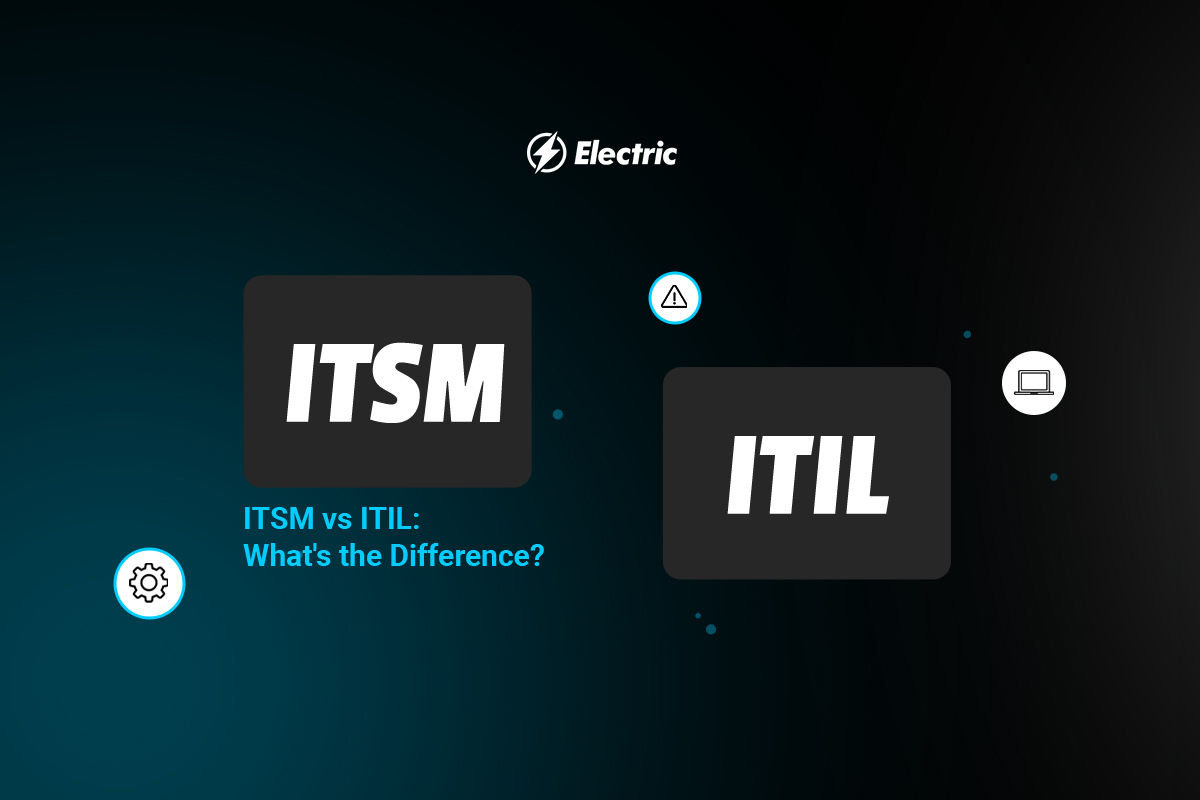
Information Technology Service Management (ITSM) and Information Technology Infrastructure Library (ITIL) work together for a seamless IT function. But, there can be some confusion when it comes to the difference between ITSM and ITIL, and the two acronyms are sometimes mistakenly used interchangeably.
In a nutshell, ITSM is the actual practice or function of managing IT operations. On the other hand, ITIL is a collection of best practices that guide IT professionals during service management. The role of ITIL is to create a framework that standardizes and enhances efficiency in service delivery. Let’s explore the differences in more detail.
IT Service Management (ITSM)
IT Service Management (ITSM) refers to all activities and processes involved in designing, creating, supporting, and managing IT services. IT services touch on many aspects, like hardware support, system controls, or software management necessary for an organization’s smooth running.
IT Service Management includes fixing systems before or after breakdown, regular maintenance, and working within a set budget. The main focus of traditional ITSM was to deliver technological solutions, while the modern approach delivers valuable services to customers — for example, an automated service desk or a process that improves change management.
IT Infrastructure Library (ITIL)
ITIL is a collection of best practices or set guidelines that ensures the effective delivery of IT services. A survey conducted by ITSM Tools revealed that approximately 53% of companies have adopted or are planning to adopt ITIL in service management. The systematic approach plays a crucial role in mitigating risks, improving customer relations, enhancing cost-effectiveness, and overseeing a stable IT environment for growth.
Typically, IT is a complex field that sometimes seems disjointed from core functions. ITIL practitioners play a crucial role in integrating IT functions in the business, automation, and promoting efficiency. The result is an IT department that strengthens the organization without hampering its goals.
ITSM vs. ITIL
Function: ITIL is the set of guidelines or frameworks used in the execution of ITSM. ITSM applies other similar frameworks like Six Sigma, DevOps, and COBIT. Therefore, ITIL is one of the best practices you can use to operationalize IT Service Management.
Uses: The role of ITIL is to align IT services to other business functions and offer valuable services to customers. ITSM, on the other hand, fulfills operations strategies like managing change to keep the company on the move.
Resource Management: ITIL brings a set framework for cost-effectiveness by minimizing waste and doing things right. IT Service Management, by comparison, ensures timely payment of utility bills and capital expenditure.
Focus: The focus of ITSM is on the entire business, whereas ITIL has a micro-focus on the IT department. ITSM enhances a business’s ability to tap IT for growth, improved efficiency, and productivity. ITIL streamlines IT Service Management to make it more effective.
Benefits of ITSM and ITIL
ITSM and ITIL both complement each other, making the IT function more efficient. Here’s a brief overview of how an organization can benefit from the two systems.
Benefits of ITSM
Better Return On Investment (ROI): Many organizations use technology to increase efficiency and productivity, while seeking to maximize their returns on the technology investment. ITSM applies different tools that ensure the services are standardized, efficient, and integrated. Ultimately, service delivery improves, which contributes to a better ROI.
Enhanced Efficiency and Productivity: ITSM applies additional features like workflow applications to achieve automation. The role of workflow management software is to optimize processes, which means less time and effort. The IT and business workforce will therefore become more efficient and productive in their roles.
Reduced Cost: Through ITSM, the IT department creates a visual workflow of IT services that improves the speed of solving lags and service delivery. In addition, ITSM applies a plethora of tools that affect workflow, standardization, and support. Although ITSM requires a considerable capital outlay, it brings tangible benefits — like reduced IT wastage or enhanced business and IT efficiency— that mitigate the cost of IT services.
Benefits of ITIL
ITIL offers businesses an effective way of delivering IT services. Here’s a broader perspective on the benefits:
-
It creates a more stable service environment that facilitates growth or a change of systems.
-
It establishes a better understanding of customers and IT services, which is vital in developing a service strategy.
-
It creates a foundation of better risk management and contingency planning.
-
It enhances a more robust integration between IT and the rest of the business.
-
It results in better service design which leads to cost reduction and optimal resource utilization.
ITSM vs. ITIL Certification
As the role of ITSM evolves from delivering technological solutions to offering value, professionals sometimes require additional skills and training. Luckily, there are plenty of ITSM certifications available, either for new entrants or those seeking to enhance their existing skills.
ITIL certification is also widely available, with various levels on offer to match your organization’s needs. The ITIL 4 scheme, for instance, has certifications with levels ranging from Foundation, ITIL 4 Managing Professional, ITIL Strategic Leader, and Master.
Typically, a professional with an ITIL certification is deemed to understand ITSM best practices. They can therefore assist businesses in optimizing IT, re-designing operations, and optimizing resources. IT practitioners can enroll for ITIL certifications to improve their career prospects and acquire a unique skillset with a deeper understanding of the ITIL framework.
Transform Your IT Function
IT is a vital department that is evolving all the time. The constant security threats, updates, changing customer demands, and compliance requirements can sometimes overwhelm your internal team’s capacity. Electric offers solutions to minimize your IT spending, standardize security, and enhance business efficiency. Contact us to learn more.



